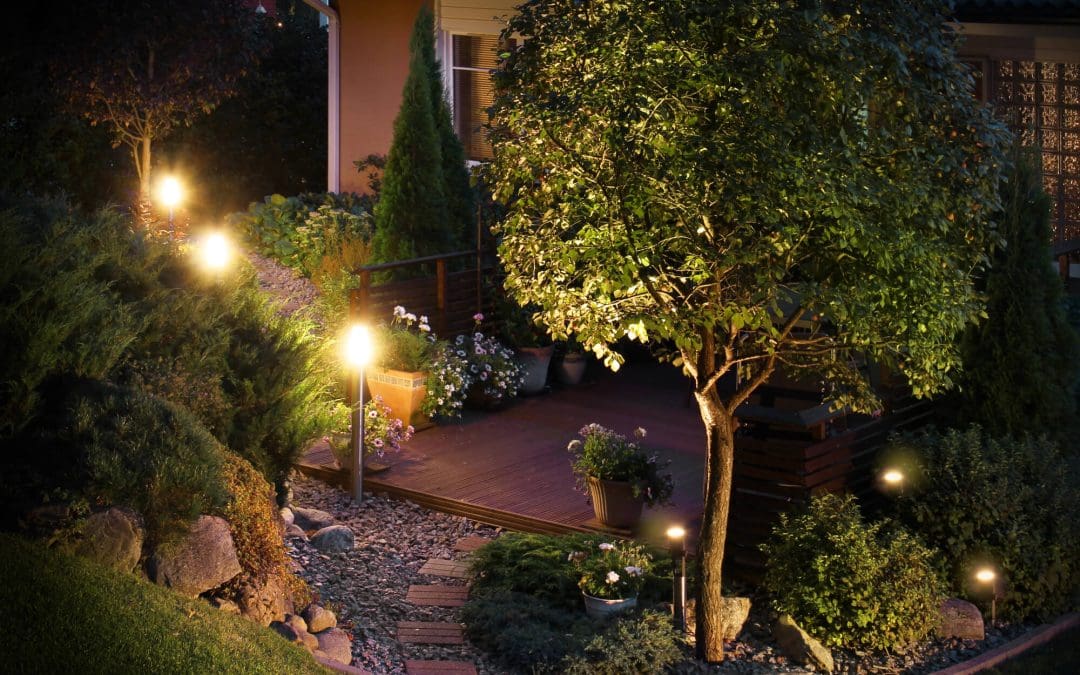Creating a beautiful and functional landscape doesn’t stop when the sun goes down. Thoughtfully planned landscape lighting can transform your outdoor space into a nighttime oasis, enhance safety, and increase the value of your home. Here’s a comprehensive guide to help you plan your landscape lighting effectively.
Assess Your Landscape
Before thinking about lighting specifics, take a moment to assess your landscape. Walk around your property at night to identify areas that could benefit from lighting. Consider pathways, entrances, garden features, trees, and any architectural details you want to highlight.
Define Your Goals for Landscape Lighting
Understanding your goals will help guide your lighting choices. Are you looking to improve safety by illuminating pathways and steps? Do you want to create a cozy ambiance for outdoor gatherings? Or perhaps you aim to showcase specific landscape features like a water fountain or a majestic tree. Defining your goals will ensure that your lighting design meets your needs.
Choose the Right Landscape Lighting Types
There are various types of landscape lighting, each serving a different purpose. Here are some popular options to consider:
- Path Lights: These small lights line walkways and driveways, providing safe passage and adding a decorative element.
- Spotlights: Highlight trees, sculptures, or architectural features. They create dramatic effects and draw attention to focal points.
- Floodlights: These provide broad illumination, perfect for lighting up large areas like lawns or gardens.
- Deck and Step Lights: These are installed directly into decks or steps, enhancing safety and adding a subtle glow to your outdoor living spaces.
- String Lights: String lights can be draped over patios, pergolas, or trees to create a festive ambiance.
Consider the Light Color and Intensity
The color and intensity of your lighting will significantly impact the overall ambiance. Warm white lights create a cozy, inviting atmosphere, while cool white lights offer a more modern, vibrant feel. Additionally, consider the intensity of the lights. Too bright, and your yard might feel harsh and unwelcoming; too dim, and the lighting may not serve its purpose. Experiment with different combinations to find the perfect balance.
Plan for Energy Efficiency
Outdoor lighting can consume a lot of energy if you don’t choose energy-efficient options. LE lights are popular due to their long lifespan and low energy consumption. Solar-powered lights are another excellent option, harnessing the sun’s energy during the day to illuminate your yard at night.
Create a Lighting Plan
Once you have a clear vision of your goals and the types of lights you want to use, it’s time to create a lighting plan. Sketch a layout of your property and mark the locations of each light. Consider factors like the height of fixtures, beam angles, and distances to ensure optimal coverage. A well-thought-out plan will help you avoid over- or under-lighting areas and provide a cohesive look.
Install Landscape Lighting with Care
Proper installation is crucial for the effectiveness and longevity of your landscape lighting. If you’re comfortable with DIY projects, you can install some types of lights yourself. However, it’s wise to hire a professional for more complex installations, especially if they are hardwired. Ensure all wiring is properly buried and protected to prevent accidents.
Maintain Your Lighting
Regular maintenance will keep your landscape lighting looking its best. Check fixtures periodically to remove dirt and debris, check for damaged or burnt-out bulbs, and trim any overgrown plants that might obstruct the light. Routine maintenance will ensure your lighting system continues to enhance your outdoor space for years.
Enjoy Your Illuminated Landscape
With careful planning and execution, your landscape lighting can transform your outdoor area into a stunning and functional space. Whether you’re hosting a gathering or simply enjoying a quiet evening outdoors, the right lighting will create a welcoming atmosphere and enhance the beauty of your home.
By following these steps, you can build a well-lit landscape that looks beautiful and enhances the safety and functionality of your outdoor space.
Landscape Lighting FAQs
How can I reduce the impact of landscape lighting on wildlife?
To reduce the impact on wildlife, use warmer color temperatures and lower-intensity lights, which are less disruptive to nocturnal animals. Avoid lighting areas near natural habitats and use shielded fixtures to direct light downward, minimizing light pollution. Motion sensors can also help by keeping lights off when not needed, reducing continuous illumination.
Can I install landscape lighting myself, or do I need a professional?
Simple installations like solar path lights or string lights can often be DIY projects. However, hire a professional for more complex setups involving electrical wiring. Proper installation ensures the safety and longevity of the lighting system.
Are there smart lighting options for outdoor landscapes?
Yes, there are smart lighting options that allow you to control your outdoor lights using a smartphone or home automation system. These systems offer features such as scheduling, dimming, color changing, and remote control. Smart lighting can enhance convenience and energy efficiency while providing customizable lighting effects.
What are the benefits of using LED lights for landscape lighting?
LED lights are energy-efficient, have a long lifespan, and produce less heat than traditional incandescent bulbs. They are also available in various colors and intensities, allowing for versatile design options. Additionally, LED lights are more durable and require less maintenance.
A&D Home Inspection provides inspection services to Central Florida. Contact us to schedule an appointment.

